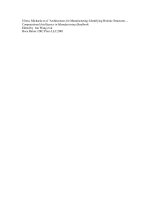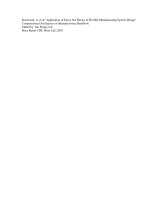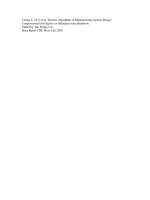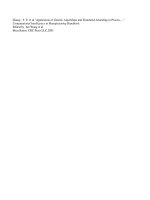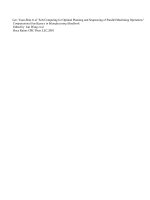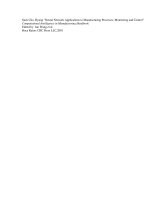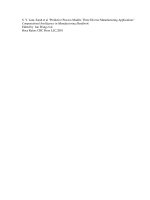Tài liệu Computational Intelligence In Manufacturing Handbook P16 pptx
Bạn đang xem bản rút gọn của tài liệu. Xem và tải ngay bản đầy đủ của tài liệu tại đây (520.74 KB, 19 trang )
Chen, Joseph C. "Neural Networks and Neural-Fuzzy Approaches in an In-Process Surface
Roughness Recognition System for End Milling Operations"
Computational Intelligence in Manufacturing Handbook
Edited by Jun Wang et al
Boca Raton: CRC Press LLC,2001
©2001 CRC Press LLC
16
Neural Networks and
Neural-Fuzzy
Approaches in an
In-Process Surface
Roughness Recognition
System for End
Milling Operations
16.1 Introduction
16.2 Methodologies
16.3 Experimental Setup and Design
16.4 The In-Process Surface Roughness Recognition
Systems
16.5 Testing Results and Conclusions
16.1 Introduction
Different machining processes produce different products with varying qualities. When evaluating the
quality of a finished piece, surface roughness is the most important result of the machining process to
consider, because many product attributes can be determined by how well the surface finish is produced.
The quality of the surface finish, or surface roughness, affects several functional attributes of parts, such
as surface friction, wear, reflectivity, heat transmission, porosity, coating adherence, and fatigue resistance.
The desired surface roughness value is usually specified for individual parts, and a particular process is
selected in order to achieve the specified roughness.
Typically, surface roughness measurement has been carried out by manually inspecting machined
surfaces at fixed intervals. A surface profilometer containing a contact stylus is used in the manual
inspection procedure. This procedure is both time-consuming and labor-intensive. In addition, a num-
ber of defective parts could be produced during the time needed to complete an off-line surface
inspection, thereby creating additional production costs. Another disadvantage of using surface profilo-
meters is that they register the serious interference of extraneous vibration generated in the surrounding
environment. This extraneous vibration might significantly influence the accuracy of surface measure-
ments. For these reasons, researchers are seeking solutions to model the surface roughness in an on-
line or in-process fashion.
Joseph C. Chen
Iowa State University
©2001 CRC Press LLC
The studies of Martellotti [1941, 1945] are among the earliest that represent a major contribution to
the understanding of kinematics and the mechanism of surface generation in milling processes. Martel-
lotti developed parametric equations to describe the trochoidal path that the tool follows. These studies
also provide approximate analytical expressions for the ideal peak-to-valley roughness generated in up-
and down-slab milling, and face milling.
Numerous other studies have explored the topography of milled surfaces. Many of these focused on
predicting the two- or three-dimensional shape of a milled surface under ideal and non-ideal conditions.
Kline et. al. [1982] demonstrated the effects of cutter runout on surface errors, and surface errors or
dimensional inaccuracies were predicted using the cantilever beam theory for cutter runout. Another
study by Babin et al. [1985] applied the cantilever beam theory to predict the topography of wall surfaces
produced by end milling. Armarego and Deshpande [1989] presented one more milling process geometry
model that incorporates cutter runout to predict cutting forces.
Sutherland and Babin [1985] demonstrated a two-dimensional worst-case analysis of the slot floor
surface. However, the model for the slot floor surface significantly underpredicted surface roughness
values. Research by Kolarits and DeVries [1989] extended the previous model to account for varying cut
geometries and feed rates. This extended floor surface generation model improved prediction capabilities
considerably. However, the roughness parameter predictions for some of the tests were found to deviate
greatly from measured values.
You and Ehmann [1989] developed a comprehensive model to predict the three-dimensional surface
texture generated by ball end mills. They also presented an algorithm for three-dimensional representa-
tions of the machined surface; however, the effect of flexibility of the cutter-workpiece system was not
considered in this model. Montgomery and Altintas [1991] presented the effects of the cutter-workpiece
system flexibility in their force and surface prediction model in order to analyze the surface generation
mechanism in peripheral milling under dynamic cutting conditions.
All models previously discussed represent only deterministic cutting models, but most machined
surfaces exhibit interrelated characteristics of both random and deterministic components. Zhang and
Kapoor [1991] demonstrated the effect of random vibrations on surface roughness in the turning process.
These vibrations were shown to occur due to random variations in the microhardness of the workpiece
material. Ismail and others presented a surface generation model in milling that included both cutter
vibrations and the effects of tool wear [Ismail et al., 1993]. Melkote and Thangaraj [1994] presented
another enhanced end milling surface texture model including the effects of radial rake and primary
relief angles. These three models, limited to laboratory usage or based on theoretical analysis, could not
be implemented as an in-process monitoring system.
The findings of this literature review, in addition to communication with leading private industrial
research and development laboratories in the state of Iowa (including Winnebago Co. in Forest City;
Delavan Inc. in Des Moines; Sauer-Sundstrand Inc. in Ames), point to the feasibility of in-process surface
roughness recognition (ISRR) systems for implementation in the newer generation of milling machines.
The successful implementation of this surface roughness recognition system will enable metal cutting
industries to reduce manufacturing costs by eliminating the relatively inefficient off-line quality control
aspect of surface roughness inspection. Therefore, reductions in manufacturing costs will increase com-
petitiveness in worldwide markets. This implication supports the development of an effective and inex-
pensive ISRR system. The development of this system will enable implementation of adaptive control in
modern manufacturing environments.
16.2 Methodologies
In order to provide an adaptive control mechanism, ISRR systems require two major components:
(i) sensors, which receive the dynamics signal from the machining cutting processes; and (ii) an intelligent
technique able to learn the dynamics of the machining system while allowing for control features to be
built in. The research described in this chapter employed an accelerometer to detect the dynamics
mechanism of the tool and material interface. This study also used two major intelligent learning
©2001 CRC Press LLC
methodologies to incorporate data about the machining process through actual cuts. These methodol-
ogies were also employed to construct a control system that predicts surface roughness during the
execution of the machining process. These two learning methodologies are artificial neural networks
(ANN) and fuzzy neural (FN) systems. An overview of these two approaches follows in the next section.
16.2.1 Neural Networks Model
Several learning methods have been developed for ANNs. Many of these learning methods are closely
connected with a certain network topology, with the main categorization method distinguished by
supervised vs. unsupervised learning. Backpropagation was chosen from among various learning methods
already existing in this field. This approach was adopted into this research for two reasons: primarily, it
is the most representative and commonly used algorithm, in addition to being relatively easy to apply;
additionally, it has been consistently successful when used in practical applications [Das et al., 1996;
Huang and Chiou, 1996].
The backpropagation algorithm can be divided into two main processes, the process of
learning
and
the process of
recalling
.
16.2.1.1 The Learning Process
Step 1. Given network parameters:
Set all the necessary parameters, such as the number of input neurons (
i
), the number of
hidden layers and the number of neurons included in each hidden layer (
h
), the number of
output neurons (
j
), etc.
Step 2: Initialize the beginning weights and biases:
Set all the initial weights and biases values randomly.
Step 3: Load the input vector
X
and the target output vector
T
of a training example.
Step 4: Calculate and infer the actual output vector
Y
.
(a) Calculate the output vector
H
of hidden layers.
Equation (16.1)
Equation (16.2)
(b) Infer the actual output vector
Y
.
Equation (16.3)
Equation (16.4)
Step 5: Calculate the error term.
(a) The error term of the output layer:
Equation (16.5)
(b) The error term of the hidden layer:
Equation (16.6)
net W xh X h
hih
i
ih
=•
∑
_–_
θ
H f net
hh
net
h
=
()
=
+
1
1 exp
–
net W hy H y
jh hj h j
=〈−__
θ
Y f net
jj
net
j
=
()
=
+
−
1
1 exp
δ
jj jjj
YYTY=
()( )
1 ––
δ
δ
hh h
hi
j
j
HH
Why
=
()
•
∑
1–
_
©2001 CRC Press LLC
Step 6: Calculate the revised weight of the weight matrix and the revised bias of the bias vector.
(a) For the output layer:
Equation (16.7)
(b) For the hidden layer:
Equation (16.8)
Step 7: Adjust and renew the weight matrix and the bias vector.
(a) For the output layer:
W_hy
hj
= W_hy
hj
+
∆
W_hy
hj
,
θ
_y
j
=
θ
_y
j
+
∆θ
_
y
j
Equation (16.9)
(b) For the hidden layer:
W_xh
ih
= W_xh
ih
+
∆
W_xh
ih
,
θ
_h
h
=
θ
_h
h
+
∆θ
_
h
h
Equation (16.10)
Step 8: Repeat steps 3 through 7, until the energy function has converged or the specified learning
cycles are completely executed.
16.2.1.2 The Recalling Process
Step 1: Set all the network parameters.
Step 2: Read the weight matrix
W_xh
and
W_hy
, and the bias vector
θ_
h
and
θ_
y
.
Step 3: Load the input vector
X
of a testing example.
Step 4: Calculate and infer the actual output Y.
(a) Calculate the output vector
H
of hidden layers.
Equation (16.11)
Equation (16.12)
(b) Infer the actual output vector
Y
.
Equation (16.13)
Equation (16.14)
16.2.2 Fuzzy-Nets Modeling
The proposed fuzzy-nets system was developed by fuzzy rules generated from sampled input–output
pairs. This model is built in five steps.
16.2.2.1 Step 1: Divide the Input and Output Spaces into Fuzzy Regions
Assume that the domain intervals of input variable
x
i
are , and that the domain intervals of
output variable
y
are [
y
–
,
y
+
]. Each domain interval can be divided into 2
N
+ 1 regions. The value of
N
is dynamic for different variables, and the lengths of each region can be equal or unequal. Each
region is denoted by
∆∆
Why H y
hj j h j j
_,_–==
ηδ θ ηδ
∆∆
Wxh X h
ih h i h h
_,_–==
ηδ θ ηδ
net W xh X h
hih
i
ih
=•
∑
_–_
θ
H f net
hh
net
h
=
()
=
+
1
1 exp
–
net W hy H y
jhj
h
hj
=•
∑
_–_
θ
Y f net
jj
net
j
=
()
=
+
1
1 exp
–
xx
ii
–
,
+
[]
©2001 CRC Press LLC
SN (Small N), S(N-1) (Small N-1), …, MD (Medium), … , LN (Large N),
Equation
(16.15)
and then assigned a fuzzy membership function. The divisions of the input and output spaces are shown
in Figure 16.1, where
N
is 2 for
x
1
, and 3 for
x
2
and
y
. The width for each variable is the same.
In this study, the input variables are spindle speed (
S
), feed rate (
F
), depth of cut (
D
), and vibration
average per revolution (
V
). The output variable is the surface roughness average value,
R
a
. A triangular
membership function specified by three parameters {
a
,
b
,
c
} is employed as follows:
Equation (16.16)
FIGURE 16.1
The domain intervals of the input–output variables and triangular membership function.
MDS1S2S3 L1 L2 L3
0
1
x
2
−
d
µ(
x
2
)
x
2
+
MDS1S2S3 L1 L2 L3
0
1
µ(y)
y
−
d
y
+
MDS1S2 L1 L2
d
µ(
x
1
)
x
1
−
x
1
+
0
triangle x a b c
xa
xa
ba
axb
cx
cb
bxc
cx
;,,
–
–
–
–
()
=
≤
≤≤
≤≤
≤
0
0
©2001 CRC Press LLC
The spread of the input feature shown in Figure 16.1 is defined as
(i = 1,2, ..., k), Equation (16.17)
where and are the domain intervals of variable
x
i
,
x
i
X
i
. There are 2
N
+ 1 fuzzy regions
quantifying the universe of discourse
X
i
.
The center points of each linguistic variable are
Equation (16.18)
Equations 16.17 and 16.18 are also used for the output variable
y.
16.2.2.2 Step 2. Generate Fuzzy Rules from Given Data Pairs through Experimentation
Three steps are used for generating fuzzy rules:
1. Determine the degree of input–output data obtained from the successful experiment.
2. Assign the input–output pairs to the region with the maximum degree.
3. Obtain one rule from one pair of designated input–output data.
In this study, the experimental input–output pairs were
Equation (16.19)
where
i
denotes the number of input–output pairs.
1. A human expert examined these rules to ensure their usefulness and correctness.
2. The degrees of each data pair were determined by the function
Equation (16.20)
where
x
c
is the center of the linguistic level
x
, and
x
s
is the width of the linguistic level
x
, equal to
d
.
3. After all of the input and output elements were determined, each element was assigned to the
region with the maximum degree.
4. One rule from one pair of the desired input–output pair [
S
1
,
F
1
,
D
1
,
V
1
,
R
a
1
], was assigned. For
example, the degree of one input–output pair: was determined by Equation 16.20 as
d
xx
N
ii
=
+
–
–
2
x
i
–
x
i
+
∈
xx d x N dx
ii i i
–– –
,,, –,.+… +
()
()
+
21
SFDVR
ii i i
a
i
,, ,, ,
[]
µ
x
xx
x
xxxx
xx
x
xxxx
i
ic
s
iccs
ci
s
icsc
()
=
∈+
[]
∈
[]
1
1
–
–
,,
–
–
,–,.
0, otherwise
